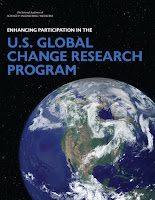Officials and scientists who write and review the nation's chief climate analysis say they are struggling to get across the risks of climate change to policymakers and the public.
Finding ways to portray risks in time scales and language that people understand remains a challenge, they said last week at a two-day meeting of the National Academies of Sciences, Engineering and Medicine.
And it's as difficult to explain risks on a localized level as it is to show, without facing accusations of fearmongering, that climate change is an existential threat to the human race, they added.
...
The U.S. Global Change Research Program, a 13-agency effort, is responsible for assembling the national climate assessment. The report is meant to be a comprehensive look at climate change impacts on the United States.
...
The authors of the report agreed that they also struggle with portraying risks where the science isn't certain yet.
"There are a number of extreme events where the science isn't quite there yet, but communicating risk could be very important," Thomas Karl, chairman of the Subcommittee on Global Change Research, which is the steering group for the 13-agency program, said.
One such area: How will the electrical distribution system be affected by more frequent ice storms and lightning?
"It's not like we're totally ignorant" of those effects, Karl said. "How we don't just push that aside" by saying the science is still uncertain is a struggle that the authors of the report face.
Timelines and solutions
At last week's National Academies meeting, White House science and technology adviser John Holdren said that one of the areas that's also been difficult to convey is the time frame of risks and potential solutions.
"There are all these different time scales in the climate problem," he said. "Folks on the whole just don't get that."
He noted that studies have begun to show risks on longer time scales, including recent research that has shown sea-level-rise risks associated with human activity and climate change will last over the next 10,000 years.
...
At the same time, the time scales for solutions are also still not clearly understood, Holdren said.
"The time scale that I think is probably most important and the least understood by most members of the public and most policymakers is exactly how long the energy system takes to be transformed," he said.
According to Holdren, the total investment in the world's energy system is about $25 trillion. Of that investment, about 80 percent is still fossil fuel infrastructure.
"Which means if you want the energy system in 2050 to look very different than it looks today," he said, "you better be changing it rapidly now because no matter how badly you want it, you can't transform a $25 trillion infrastructure that is now 80 percent fossil fuel very quickly."
Read more at Top Scientists Find It Hard to Make Public See Risks

No comments:
Post a Comment